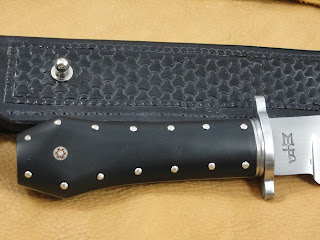This is the third knife I've been working on in the hunting season threesome, though it ended up there by chance - no one is going hunting with this one (yet).
This style of Bowie was made in the 1800s in the US, and I really like them. This one has a 9 1/2 inch blade of 1084. I forged it from 3/16s stock so it's a slim blade that should cut very well. Like the hunting knives in the previous post this was heat-treated in my new digital furnace, and I can tell the difference - they are just a bit harder. They ring at a higher note when you tap them. The real test will be how long they hold an edge. To quote Roman Landis (a knife-making engineer who spoke at the last conference I went to): "Geometry cuts. Heat treat determines for how long."
This is a frame handled knife - meaning the steel you see around the edge of the handle is not part of the blade, but is a frame slipped over the tang. I should have taken a picture - trying to explain it further will be futile. Anyways, the frame, guard, and the ring behind the guard are all 316 stainless steel. The handle body is black micarta (a paper and resin composite) held on by 14 nickel silver pins. The main pin in the middle of the handle is a 'mosaic' pin. It's a tube of nickel silver with other smaller tubes and dowels of various metals slipped down it to make a pattern. I buy it in 6" pieces from a supply house and cut it to size myself.
One thing I hate about pictures of knives is that cameras just can't capture the finish on blades. Reflective metal surfaces really need to be moved so you can see the light play off them. I finished this blade down to 600grit by hand, and I love the surface but it just doesn't come across in pictures:
You can get an idea of what it looks like in person from this picture. It's kind of satin-y, but you can also see the reflection of the camera and my hand in the blade if you look at the right side.
I'll probably put this one up on Etsy.
Next project is finishing a 12" blade-carved seax, and then a sgian-dubh (Scottish sock knife).



